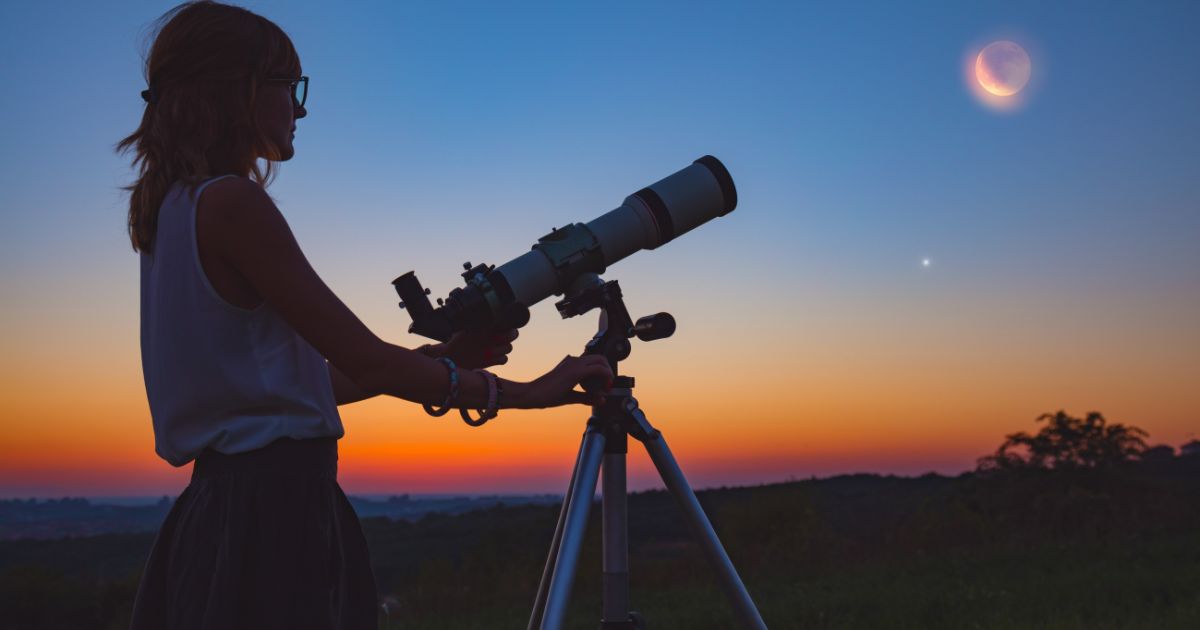ASTRONOMICAL ALMANAC for January 2021
As we write this section for 2021, “social distancing” is encouraged. As a stargazer and amateur astronomer, I stretch my legs with walks under the stars. There are more creatures wandering about in the country than in the city. During these walkabouts, there is a sense that all will be well as long as you can see the sky. You may enjoy the passing urban-scape or, by looking higher, watch the universe pass between the tree branches. Although a rural home will have many more visible stars above, you will still be able to pick out some of the brighter stars and constellations from a city. The trick is to find a pathway that does not pass by bright artificial (anthropogenic) lighting.
A keen eye and a pair of binoculars are all that are needed to see and enjoy the large-scale structure of the night sky, and to find interesting celestial objects. Their light has been dimmed by distance, so you have to look carefully. The challenge and a victory is in finding each object.
We hope that the following pages will entice you to go on these evening walkabouts and seek out places without artificial lights, so you can take full advantage of this guide. Discovering the sky is a leisurely activity, so take your time and enjoy it as it comes—don’t force it.
GUIDANCE FOR BEGINNERS
The times of events presented in this section are based on the city of Ottawa. It is common for almanacs to be centred on the capital of the country for which they are designed. Purely celestial events happen at the same absolute time across the country. Since Canada is such a broad country, the time of celestial events must be corrected for your time zone, whether west of Ottawa (add hours) or east (subtract hours). Other events involving a terrestrial reference will require additional corrections for your distance from Ottawa, which are provided in the Ottawa Time Corrections table.
DETERMINING LOCAL TIME FOR LOCAL EVENTS
Most celestial events listed in the “Notable Events” column only need correction for your time zone difference from eastern time (Ottawa). However, the sun and moon times, and events that reference the horizon or meridian, will benefit from the Ottawa Time Corrections table because risings, settings and transits depend on your difference in latitude and longitude from Ottawa.
Once you make the time zone correction from Ottawa’s eastern time zone to your time zone, you must then apply the Ottawa Time Corrections table to get more accurate local times. This corrects for your longitude within your time zone, as well as the latitude difference between Ottawa and your city. To your initial time zone correction from eastern time, add the number in the table corresponding to the month and your city, or subtract it if the number is negative.
The entries are given for mid-month so you may wish to interpolate to specific days for more accurate values. There will be additional errors due to interpolation of the data if you are not in the city centre or at ground level; however, these will be relatively small.
MONTHLY TABLES
These tables provide the times of numerous celestial events. To save space, the sun and moon information and other celestial events are listed using only Ottawa time, which adopts daylight time at 2 a.m. on March 14, 2021, until at 2 a.m. on November 7, 2021. Those living in Saskatchewan and a few other local areas must convert these times back to standard time. Sorry.
Sunrise and Sunset Columns
Sunrise is defined as the moment when the upper edge of the sun first clears the horizon; sunset is timed when the upper limb disappears. The published times are for a level horizon unobstructed by terrain, trees or buildings. We have already applied an average correction for atmospheric refraction (about 1/2 degree), which makes sunrise earlier and sunset later, but the actual amount depends on the air density on that day and is not significant for a casual stargazer.
Although the sun may be below the horizon, it still illuminates the high-altitude atmosphere. This causes the lingering light of dusk and dawn. The beginning and end of these are included in the tables as “civil twilight.” At the end of civil twilight, the sky will be dark enough for casual observing.
We list the azimuth angle of sunrise and sunset, where azimuth is defined as the angle from true north around the horizon toward the east (i.e., east is 90-degrees azimuth). The altitude of the sun at midday is in degrees above the southern horizon as seen from Ottawa. You will have to make corrections for the latitude of your city. Take the difference in the degrees of latitude of your city from Ottawa (45 degrees). It will be positive if you are south and negative if you are north. Add this number to the value in the “Alt.” column. “”
Note that the direction north indicated by a compass refers to magnetic north, which is not the same as true north. The difference is called the “magnetic variation” or “grid declination,” which can be determined by referring to geomag.nrcan.gc.ca/calc/mdcal-en.php. If you are using a magnetic compass to get true north, you need to correct the direction given by your compass by adding (“west”) or subtracting (“east”) your local magnetic variation or grid declination to the azimuth shown by your compass.
Moonrise and Moonset Columns
The definitions for the “Moonrise” columns are similar to those for the “Sunrise” columns. Moonrise and moonset times are for Ottawa, but there is no simple way of applying them to other places because the moon drifts in position with respect to the stars by its own diameter every hour. This is because it orbits eastward around Earth about 15 degrees every day opposite to the motion of the celestial sphere. (You can see this by watching it pass a bright star during an evening.)
If you live in Southern Canada, applying the sunrise/sunset correction to the times of the moonrise and moonset will put you within 10 to 20 minutes of the actual time. Occasionally, an entry is blank when moonrise or moonset is after midnight. In those cases, it appears on the line for the next day.
Notable Events
This column will make you aware of various other celestial events and help you identify specific stars, planets and celestial objects. We give the time for the celestial events in a 24-hour format (hh:mm). These events only need your time zone correction. To differentiate the local horizon- and meridian-related events, we use an a.m. and p.m. format. These require both a time zone and Ottawa Time Corrections to be applied. To help read the table, just highlight the line for the city nearest you.
The “Notable Events” column lists the day the sun crosses constellation boundaries, as well as the lunar phases. The lunar cycle begins at new moon, then passes through first quarter at about 7 or 8 days of age, while full moon is at about 15 days of age and last quarter is about 21 days old. The moon passes through its cycle in 29.5 days. The moon’s age in days is a convenient way to time the phase. The lunar phase occurs at about the same moment in Vancouver as in Ottawa—so it only needs to be corrected for your time zone.
TIDES ALONG THE CANADIAN COASTS
The Canadian Hydrographic Service publishes tide tables for many marine harbours on the Atlantic, Arctic and Pacific coasts. These are freely available at tides.gc.ca during the year of their use (2021).
I hope your skies will be clear and you will enjoy your astronomical almanac. Have a great 2021!
January
The times in the “Notable Events” column have two formats for time. Those given as a.m. and p.m. only need to be corrected to your time zone. The event times given in 24-hour format require correction for your time zone and the Ottawa Time Corrections table. The year begins with a bright moon rising in the east after sunset. This is good, because after the joy of the holidays fades, the night gets dark as the moon wanes toward a new moon in mid-month. However, this makes the year’s first meteor shower a bust because the bright moonlit sky will overwhelm the fainter meteors. While the moon is out of the sky during any month, use the “Notable Events” column to help you locate and identify constellations and other celestial objects. Common binoculars will help.
NOTABLE EVENTS
DATE
Jan 1 Year begins with 90% gibbous moon in east
Jan 2 Quadrantid meteor shower
Jan 3 Little Dipper “hangs” below North Star at 8 p.m.
Jan 6 Last-quarter moon
Jan 13 New moon
Jan 14 Persius near zenith at 8 p.m.
Jan 16 Leo rising in east at 8 p.m.
Jan 19 Sun enters Capricornus; Pleiades cluster on meridian at 8 p.m.
Jan 20 First-quarter moon
Jan 21 At 8 p.m., Cygnus (Northern Cross) vertical over NW horizon; Uranus 1.75 degrees south of Mars
Jan 23 Mercury max elongation (18.6 deg – eve)
Jan 28 Full moon
Jan 30 Hyades cluster of meridian at 8 p.m.

OTTAWA TIME CORRECTIONS (IN MINUTES): USE FOR HORIZON- AND MERIDIAN-RELATED EVENTS

*Saskatchewan and a few other areas in British Columbia and Ontario do not switch to daylight time.
They must add 1 hour between March 1 and March 14 at 2 a.m., and subtract 1 hour for November 1 to November 7 at 2 a.m.




One of Canada’s foremost writers and educators on astronomical topics, the Almanac has benefited from Robert’s expertise since its inception. Robert is passionate about reducing light pollution and promoting science literacy. He has been an astronomy instructor for our astronauts and he ensures that our section on sunrise and sunset, stargazing, and celestial events is so detailed and extensive it is almost like its own almanac.













